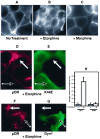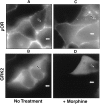Morphine-activated opioid receptors elude desensitization by beta-arrestin
- PMID: 9707575
- PMCID: PMC21436
- DOI: 10.1073/pnas.95.17.9914
Morphine-activated opioid receptors elude desensitization by beta-arrestin
Abstract
mu opioid receptors are targets of native opioid peptides and addictive analgesic drugs. A major clinical liability of opiate drugs is their ability to cause physiological tolerance. Individual opiates, such as morphine and etorphine, differ both in their ability to promote physiological tolerance and in their effects on receptor regulation by endocytosis. Here, we demonstrate that arrestins play a fundamental role in mediating this agonist-selective regulation and that morphine-activated mu receptors fail to undergo arrestin-dependent uncoupling from cognate G proteins. Thus, highly addictive opiate drugs elude a fundamental mode of physiological regulation that is mediated by agonist-specific interaction of opioid receptors with arrestins.
Figures




Similar articles
-
Functional dissociation of mu opioid receptor signaling and endocytosis: implications for the biology of opiate tolerance and addiction.Neuron. 1999 Aug;23(4):737-46. doi: 10.1016/s0896-6273(01)80032-5. Neuron. 1999. PMID: 10482240
-
Mu-opioid receptor desensitization by beta-arrestin-2 determines morphine tolerance but not dependence.Nature. 2000 Dec 7;408(6813):720-3. doi: 10.1038/35047086. Nature. 2000. PMID: 11130073
-
Enhanced morphine analgesia in mice lacking beta-arrestin 2.Science. 1999 Dec 24;286(5449):2495-8. doi: 10.1126/science.286.5449.2495. Science. 1999. PMID: 10617462
-
Mechanisms of rapid opioid receptor desensitization, resensitization and tolerance in brain neurons.Br J Pharmacol. 2012 Mar;165(6):1704-1716. doi: 10.1111/j.1476-5381.2011.01482.x. Br J Pharmacol. 2012. PMID: 21564086 Free PMC article. Review.
-
Opioid regulation of mu receptor internalisation: relevance to the development of tolerance and dependence.CNS Neurol Disord Drug Targets. 2010 Nov;9(5):616-26. doi: 10.2174/187152710793361522. CNS Neurol Disord Drug Targets. 2010. PMID: 20632966 Review.
Cited by
-
Mu-opioid receptor and receptor tyrosine kinase crosstalk: Implications in mechanisms of opioid tolerance, reduced analgesia to neuropathic pain, dependence, and reward.Front Syst Neurosci. 2022 Dec 1;16:1059089. doi: 10.3389/fnsys.2022.1059089. eCollection 2022. Front Syst Neurosci. 2022. PMID: 36532632 Free PMC article. Review.
-
Chronic morphine treatment inhibits opioid receptor desensitization and internalization.J Neurosci. 2002 Dec 1;22(23):10192-200. doi: 10.1523/JNEUROSCI.22-23-10192.2002. J Neurosci. 2002. PMID: 12451120 Free PMC article.
-
Resistance to morphine analgesic tolerance in rats with deleted transient receptor potential vanilloid type 1-expressing sensory neurons.Neuroscience. 2007 Mar 16;145(2):676-85. doi: 10.1016/j.neuroscience.2006.12.016. Epub 2007 Jan 17. Neuroscience. 2007. PMID: 17239544 Free PMC article.
-
A Balancing Act: Learning from the Past to Build a Future-Focused Opioid Strategy.Annu Rev Physiol. 2024 Feb 12;86:1-25. doi: 10.1146/annurev-physiol-042022-015914. Epub 2023 Nov 29. Annu Rev Physiol. 2024. PMID: 38029388 Free PMC article. Review.
-
Agonist-specific regulation of mu-opioid receptor desensitization and recovery from desensitization.Mol Pharmacol. 2008 Apr;73(4):1301-8. doi: 10.1124/mol.107.042952. Epub 2008 Jan 15. Mol Pharmacol. 2008. PMID: 18198283 Free PMC article.
References
-
- Evans C J. In: Diversity Among the Opioid Receptors. Korenman S G, Barchas J D, editors. New York: Oxford University Press; 1993. pp. 31–48.
-
- Grudt T J, Williams J T. Rev Neurosci. 1995;6:279–286. - PubMed
-
- Matthes H W, Maldonado R, Simonin F, Valverde O, Slowe S, Kitchen I, Befort K, Dierich A, Le M M, Dolle P, et al. Nature (London) 1996;383:819–823. - PubMed
-
- Yu Y, Zhang L, Yin X, Sun H, Uhl G R, Wang J B. J Biol Chem. 1997;272:28869–28874. - PubMed
Publication types
MeSH terms
Substances
Grants and funding
LinkOut - more resources
Full Text Sources
Other Literature Sources
Research Materials

